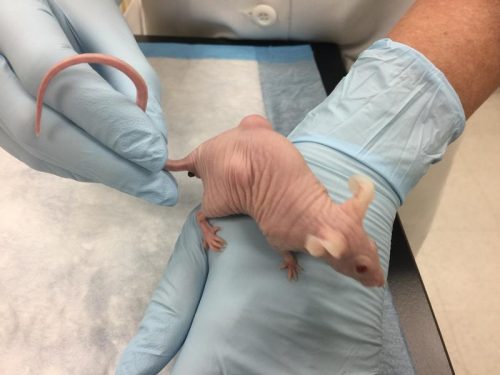Source: tpr.org
Author: Wendy Rigby
San Antonio researchers are working on a new therapy for a stealthy killer: oral cancer. Visits to the dentist are your number one protection against the disease. In a lab at the University of Texas Health Science Center at San Antonio, dental researcher Cara Gonzales, DDS, Ph.D., shared promising news on a new approach to healing.
“It was very exciting,” Gonzales said. “These patients have not had any new therapeutic options in 40 years.”
The discovery of a new gene that’s turned on in oral cancers gave Gonzales and her colleagues a new target at which to aim. It’s a gene that’s also found in lung cancers.
Gonzales works in a sprawling space filled with lab equipment and cell lines used in many molecular biology projects. One of her research assistants brought in a cage of lab animals with some strange lumps on their backs.
“These are called nude mice because they don’t have a complete immune system,” Gonzales explained.
These mice are at the center of a successful experiment. First, scientists used human oral cancer cells to grow large tumors on the animals. They tried one oral cancer drug already on the market. Not much action. Then, they tried a lung cancer drug, also already approved by the Food and Drug Administration. Not that effective on its own. Finally, they used a combination of two drugs. What happened made the medical profession take notice.
“When we combined the two, then we saw a 50 percent reduction in the tumor volumes after 14 days,” Gonzales described.
That kind of success could help thousands of patients whose cancers aren’t caught until the later stage, patients like Paige Lewis of San Antonio who was only 35 when she got the results of a biopsy from her doctor.
“I walked in and she said the words I’ll never forget,” Lewis recalled. “‘Sweetie, it’s cancer.’”
Lewis had tried for a year to get various doctors and her dentist to examine and biopsy the strange spot under her tongue. But no one really thought she was at risk for the disease.
“I was told it’s most likely nothing because I’m young. I was only 35 years old. I was a female non-smoker, non-drinker,” Lewis said.
While smoking, drinking and age are big risk factors for oral cancer, so is the presence of the human papillomavirus in the body. Some cases, like Lewis’, are simply unexplained.
Since her cancer was so advanced, Lewis, a single mother of three children, faced a massive surgery and weeks of radiation. Paige still bears scars on her arm from a major surgery where doctors removed her tumor and rebuilt her tongue.
“They removed half of my tongue,” she described. “They harvested part of my arm in order to place a flap in my mouth. And then a part of my leg to cover part of my arm.”
Lewis spent 20 days in the intensive care unit. If her cancer had been detected earlier, or if doctors had the ability to shrink her tumor, her ordeal would have been less painful and less risky. Only slightly more than half of all oral cancer patients are alive five years after their treatment. Lewis is four years out.
U.T. Health Science Center researchers are trying to secure funding for human trials which may take place in San Antonio. The pills used in this new combination target tumors specifically, so patients would not suffer as many side effects as they do with conventional chemotherapy, side effects like hair loss and gastrointestinal issues.
Dr. Cara Gonzales’ oral cancer paper was published in the journal Oral Oncology.
“If we can find something that would treat these advanced tumors, we could potentially increase the survival rate of approximately 25 percent of all oral cancer patients,” Gonzales stated.
Lewis is coping well with the side effects of surgery and radiation, but it hasn’t been easy. “Cancer takes over your life during that period of time. And it affects every single person you know,” Lewis said. “All of this could have been avoided with an early diagnosis.”
An oral cancer screening at the dentist only takes two minutes, and checking for oral cancer should be part of a regular dental screening. Like Lewis and thousands of others, though, you may have to insist the hygienist or dentist examine your mouth, tongue and gums in detail. Having a medical professional look for signs and symptoms of the disease is still the best defense against oral cancer which claims an average of one American life every hour.


Leave A Comment
You must be logged in to post a comment.